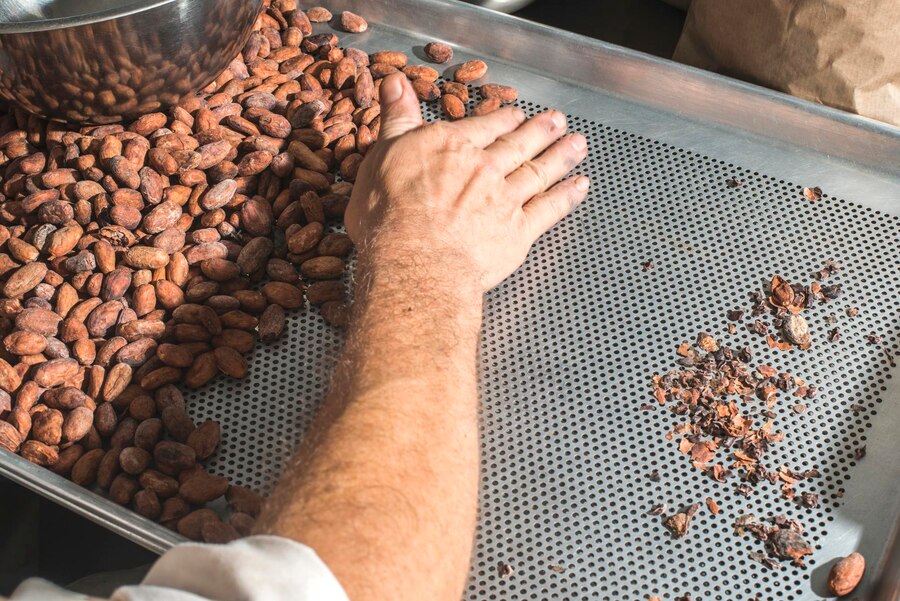he Roasting cacao is a key step in transforming raw cacao beans into the rich, flavorful chocolate we all know and love. Whether you’re a chocolate enthusiast or a hobbyist looking to create your own chocolate from scratch, understanding how to roast cacao beans is an essential skill. In this comprehensive guide, we’ll walk you through the roasting process, highlight the best techniques, and provide up-to-date, valuable information on this time-honored tradition.
What is Cacao, and Why Should You Roast It?
Cacao beans are the seeds of the cacao tree (Theobroma cacao), a tropical evergreen found in regions like South America, West Africa, and Southeast Asia. Cacao is the raw material used to create all types of chocolate, from dark to milk chocolate, as well as cocoa powder and cocoa butter.
Roasting cacao is essential for several reasons:
- Flavor Development: Raw cacao beans have a very bitter and harsh flavor. Roasting enhances the complex flavors, bringing out the characteristic chocolate notes.
- Ease of Processing: Roasting helps separate the cacao nibs from the shell, making it easier to process the beans into a smooth paste.
- Aroma: The roasting process releases aromatic oils that give chocolate its distinctive smell, which is one of the most recognizable and appealing qualities of chocolate.
The Science Behind Roasting Cacao
Roasting cacao is a delicate process that requires careful temperature control. The heat causes chemical reactions within the beans, primarily Maillard reactions (which contribute to flavor development) and caramelization (which gives the beans a rich, roasted taste). Temperature and time are key factors—too much heat can burn the beans, while too little will leave them underdeveloped in flavor.
Step-by-Step Guide: How to Roast Cacao Beans
Roasting cacao beans is straightforward once you understand the process and the variables that affect the outcome. Here’s how to do it, whether you’re using an oven, stovetop, or specialized cacao roaster.
Step 1: Prepare Your Cacao Beans
Start by sourcing high-quality cacao beans. You can buy raw, unroasted cacao beans online or from specialty shops. Ensure the beans are cleaned, removing any debris or damaged beans.
Step 2: Preheat Your Roaster or Oven
The temperature at which you roast cacao beans is crucial for achieving the right flavor. For most methods, the ideal temperature range is between 250°F and 320°F (121°C to 160°C). Preheat your roaster, oven, or stovetop accordingly.
Step 3: Choose Your Roasting Method
There are a few different ways to roast cacao beans, each with its own pros and cons. Let’s explore the most common methods:
Method 1: Oven Roasting
- Preheat the oven to around 300°F (150°C).
- Spread the cacao beans evenly on a baking sheet, ensuring they aren’t crowded. This helps the heat circulate evenly around the beans.
- Roast for 15 to 30 minutes, checking periodically. The beans should crack and produce a lovely chocolatey aroma.
- Cool the beans after roasting by removing them from the oven and letting them sit at room temperature.
The Method 2: Stovetop Roasting
- Use a heavy pan or skillet (preferably cast iron) to distribute heat evenly.
- Preheat the pan on medium-low heat.
- Add cacao beans and roast them for 10-20 minutes, stirring frequently to prevent burning.
- Cool the beans by removing them from the pan and setting them aside.
Method 3: Dedicated Cacao Roaster
For those who are serious about cacao roasting, a cacao roaster can provide precise control over the temperature and airflow. Roasters are designed specifically to handle cacao beans, ensuring a consistent and even roast.
- Set your roaster to the desired temperature (typically between 250°F and 300°F).
- Load the cacao beans into the machine.
- Roast for 20 to 30 minutes, depending on your preferred level of roast.
- Cool the beans as soon as the roasting process is complete.
Step 4: Cracking and Winnowing the Beans
After roasting, you’ll need to separate the cacao nibs from the outer shell. This process is called winnowing. The beans will naturally crack into smaller pieces once they’ve cooled, making it easier to remove the shells.
- Crack the beans by gently crushing them with a rolling pin or in a food processor.
- Separate the nibs from the husks by hand or by using a winnower (a specialized machine that helps sift the nibs from the shells).
- Collect the nibs for the next stages of chocolate-making, or enjoy them as they are—raw cacao nibs are incredibly healthy and flavorful.
Step 5: Grind the Nibs (Optional)
If you’re planning to make chocolate, you’ll need to grind the nibs into a smooth paste, called cocoa liquor. This can be done using a food processor, a stone grinder, or a specialized chocolate grinder.
Factors to Consider While Roasting Cacao
When roasting cacao, several factors can impact the final product, including:
- Roast Level: Cacao beans can be roasted lightly, medium, or dark, depending on your preference. Lighter roasts preserve more of the original bean flavors, while darker roasts tend to bring out bolder, more bitter notes.
- Bean Type: Different varieties of cacao beans, like Forastero, Criollo, and Trinitario, have unique flavor profiles that respond differently to roasting.
- Time and Temperature: The longer you roast, the more the flavors will develop, but be cautious not to overdo it. The optimal roasting time is between 15 to 30 minutes at 250°F to 320°F, depending on your method.
Common Mistakes to Avoid When Roasting Cacao
- Over-roasting: If you leave the beans in the heat too long, they can burn, resulting in a bitter, unpleasant taste.
- Uneven Roasting: Ensure the beans are spread evenly for consistent roasting. Crowding the beans can lead to uneven results.
- Not Monitoring the Temperature: Overheating can cause bitterness and off-flavors. Be sure to use a thermometer to keep the temperature consistent.
Different Cacao Roasting Methods
| Method | Equipment Needed | Time | Temperature Range | Flavor Profile | Pros | Cons |
|---|---|---|---|---|---|---|
| Oven Roasting | Oven, Baking Sheet | 15-30 minutes | 250°F – 320°F | Rich, chocolatey, less bitter | Easy, accessible, even heat distribution | Can be slow, requires monitoring |
| Stovetop Roasting | Cast Iron Pan, Spatula | 10-20 minutes | Medium heat | Smoky, bold, caramelized notes | Quick, direct control over heat | Needs constant stirring, uneven heat |
| Cacao Roaster | Cacao Roaster Machine | 20-30 minutes | 250°F – 300°F | Consistent, deep chocolate flavor | Precise control, optimal results | Expensive, requires specialized equipment |
Health Benefits of Roasting Cacao Beans
In addition to its rich flavor, roasted cacao offers several health benefits. Cacao is packed with antioxidants, magnesium, and iron, which contribute to overall health. The roasting process retains many of these nutrients, making roasted cacao a healthy snack choice.
- Rich in Antioxidants: Roasted cacao is a powerful source of flavonoids, which help protect the body from oxidative stress.
- Heart Health: The compounds in cacao may help lower blood pressure, improve blood flow, and reduce the risk of heart disease.
- Brain Function: Cacao contains neuroprotective compounds that may help improve cognitive function and memory.
Conclusion: Mastering the Art of Cacao Roasting
Learning how to roast cacao is both a rewarding and enjoyable process. By following these steps, you can create perfectly roasted cacao beans, whether for homemade chocolate or as a tasty treat in its own right. Experiment with different roast levels, time, and temperature to discover your preferred flavor profile. Whether you use an oven, stovetop, or dedicated cacao roaster, roasting cacao opens up a world of flavors, health benefits, and possibilities.
By following this guide and avoiding common mistakes, you’ll be well on your way to perfecting the art of cacao roasting. Remember, the key to great cacao lies in a balance of temperature, time, and technique. Happy roasting!










